The NVIDIA GeForce GTX 970 Review: Featuring EVGA
by Ryan Smith on September 26, 2014 10:00 AM ESTOverclocking
With GTX 980 we saw first-hand how GM204 had very significant overclocking headroom. Even without the ability to meaningful overvolt on NVIDIA cards, we were able to push our base GPU clock speed up from 1126MHz to 1377MHz, or in terms of the maximum boost bin, from 1265MHz to 1515MHz. Consequently with GTX 970 shipping at lower clock speeds, we have very lofty expectations here.
But running counter to that will be TDP. As we have already seen, GTX 970 is TDP limited right out of the gate, so even if our card has more clock speed headroom, its 110% TDP limit doesn’t leave much more in the way of power headroom. Furthermore as this is already a factory overclocked card, there’s no guarantee that EVGA has left us much overclocking headroom to play with in the first place.
| EVGA GeForce GTX 970 FTW Overclocking | ||||
| FTW | Overclocked | |||
| Core Clock | 1216MHz | 1241MHz | ||
| Boost Clock | 1367MHz | 1392MHz | ||
| Max Boost Clock | 1418MHz | 1455MHz | ||
| Memory Clock | 7GHz | 7.8GHz | ||
| Max Voltage | 1.218v | 1.243v | ||
And in fact our results show they haven’t. We aren’t able to get even another 50MHz out of our GPU before errors start setting in; 25MHz is all we will get, which pushes our base GPU clock speed from 1216MHz to 1241MHz, and our maximum boost clock from 1418MHz to 1455MHz. Overall this is a weaker overclock than GTX 980, though not immensely so.
Meanwhile memory overclocking was just as fruitful as it was on GTX 980, with our card being able to handle up to 7.8GHz on its GDDR5 memory. As we saw with GTX 980 we’re nearly as memory bandwidth bottlenecked as we are GPU bottlenecked, but we will take what performance we can get.
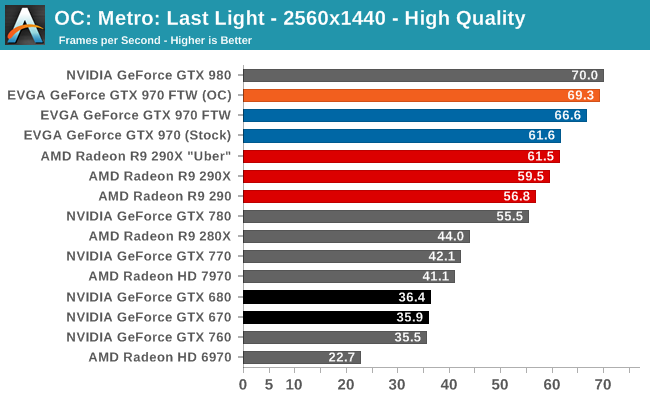
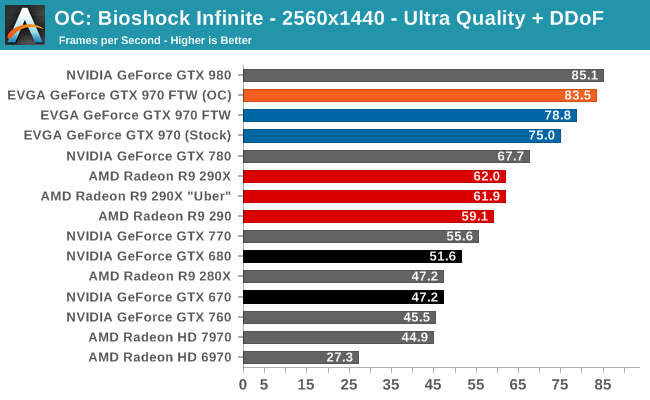
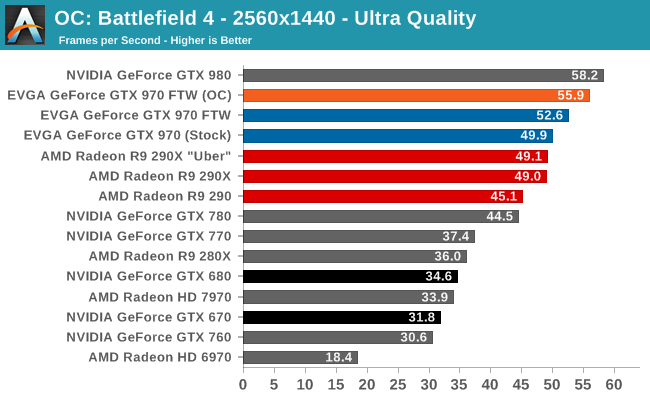

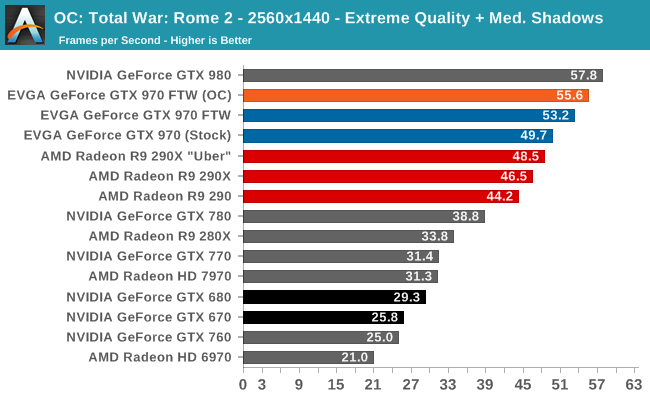
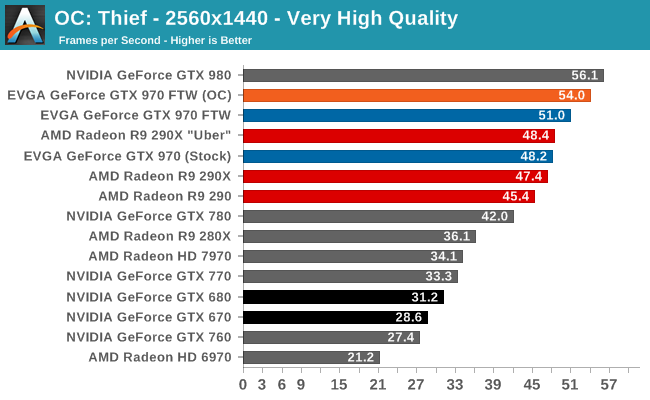
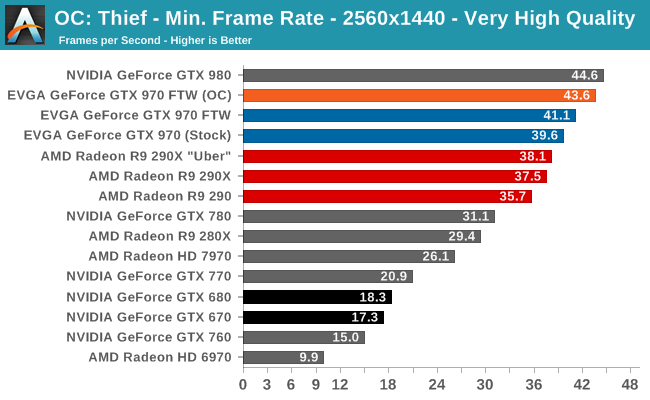
As you’d expect from such a mild overclock, the performance increase is very limited. Our overclocked GTX 970 FTW does close on GTX 980 even more, but even with this full overclock it won’t overcome the 3 SMM deficit.
Overall in all likelihood the GTX 970 FTW benefits more from the 10% increase in TDP than it does the clock speed increase. GTX 970 – and GM204 in general – clearly desires to be fed with more voltage and more power overall than what any NVIDIA approved card is going to see.
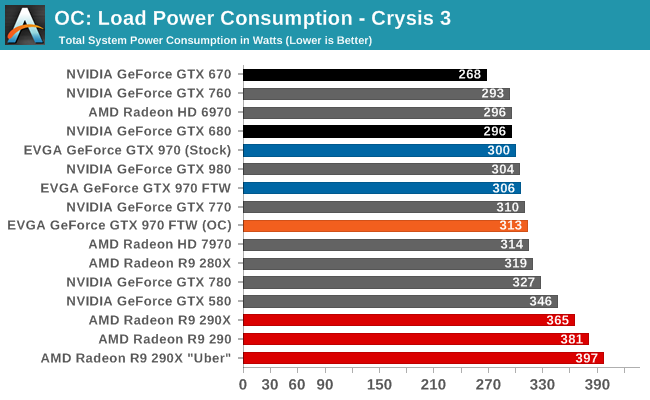
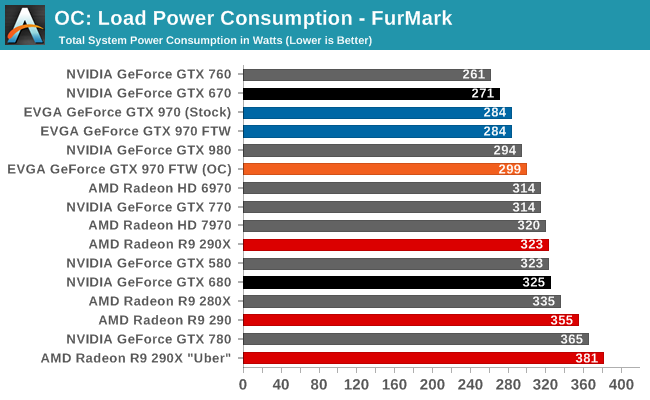
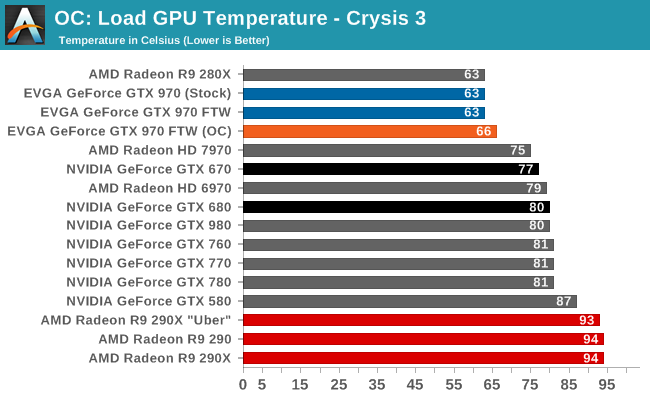
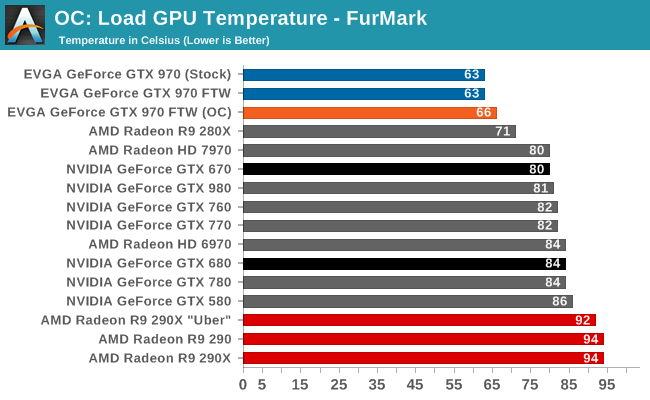
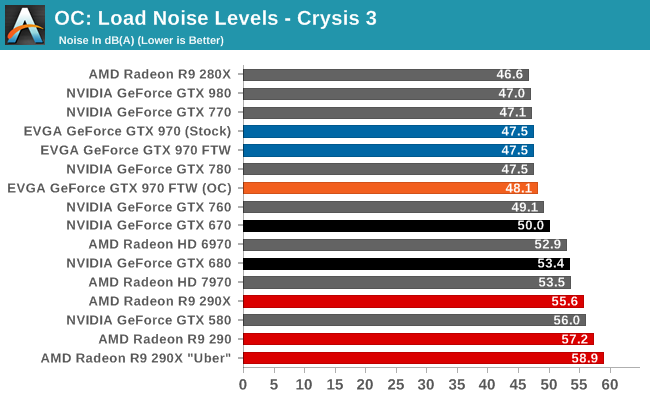
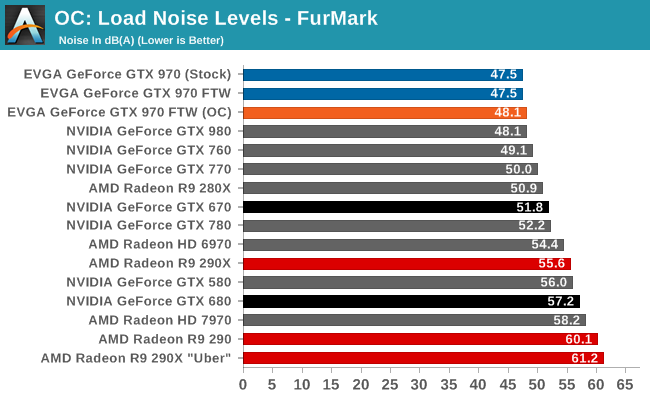
Power consumption and noise tick up, but only slightly. The limited 10% TDP increase means that the amount of power the card can draw and dissipate as heat only increases slightly. You aren’t getting much more performance, but you also aren’t getting much more noise.










155 Comments
View All Comments
MrSpadge - Saturday, September 27, 2014 - link
What you describe is what Tonga should have been. Didn't turn out so well :/Sure, the 285 is priced below GM204 cards, but the chip is almost as large and hence costs AMD the same to produce it. They SHOULD play in the same league.
thepaleobiker - Friday, September 26, 2014 - link
"Crysis 3 Summary" - The GTX 670 trails the R9 290XU by 10%....It should be the GTX 970 :)
Also, on the page with Company of Heroes - The Charts do not display correctly, or more specifically, their headers (the thick Blue bar/heading with info about resolution etc?) are cropped out on all the images except the first one.
Regards,
Vishnu
krazyfrog - Friday, September 26, 2014 - link
Also, last page, fifth paragraph"AMD would have to cut R9 290X’s performance by nearly $200 to be performance competitive, and even then they can’t come close to matching NVIDIA’s big edge in power consumption."
Should be '290X's price', I believe.
CZroe - Friday, September 26, 2014 - link
I have the reference style 4GB EVGA GTX 760 with the short PCB but it was discontinued shortly after launch. I got some 670/760 water blocks for SLI from Swiftech and found that only Zotac was making a short PCB 4GB GTX 760 card like my EVGA even though it has fewer memory chips (probably worse for over locking). Because the vast majority of GTX 760 cards had reference 680 PCBs, it is very difficult to tell which "reference" 760 this article is talking about. The rare short PCB or the longer one?Ryan Smith - Friday, September 26, 2014 - link
The short PCB and the stretched PCB were virtually identical, so to answer the question I'm technically comparing it to the short PCB, but either comparison is valid. The stretched section only contains a handful of additional discrete components; it's mostly to allow fitting an open air cooler.Atari2600 - Friday, September 26, 2014 - link
The Radeon 290x is nearly a year old now. It would be surprising if an Nvidia GPU that sacrifices DP capability wouldn't be significantly quicker per mm^2 at this point.The improvement in performance/watt is notable and nvidia deserve much credit for their work in this area.
Phasenoise - Friday, September 26, 2014 - link
Oh my the name of that card. "EVGA GeForce GTX 970 FTW ACX 2.0"Reads like my niece's texting log. omg lol gtx ftw, btb.
jjj - Friday, September 26, 2014 - link
"considering the fact that GTX 970 is a $329 card I don’t seriously expect it to be used for 4K gaming"You should and Nvidia should market it as lowering the entry price for 4k. It's kinda the least you need for 4k, can do 4k just not max setting everywhere for just 329$. Pair it with some bellow 500$ screen deal and 4k gaming is a lot more accessible than 2 weeks ago.
We've looked at what's the bare minimum for 1080p for years and we are used to it, now it's 4k's turn to become more mainstream and we need to get used to looking at it the same way.
in the US and even more so in China 4k screens are not that prohibitive anymore. 400-500$ for a screen, 330$ for a 970, an overclocked dual core and you can do budget 4k gaming at 1.2k$.
4k should be one of the reasons some people that buy 200$ cards might go for the 970 this time around.
And with 20nm 4k should become a lot more affordable so it's time to not think of it as a small niche.
garadante - Friday, September 26, 2014 - link
Can we get power usage with non reference 290/290X's? If I recall correctly, power usage drops something like 15-25 watts when it's running at closer to 70 C than 95 C as reference cooling profiles make it run.justaviking - Friday, September 26, 2014 - link
Zero Fan Speed Idling...Will the zero fan speed capability be something that will be delivered via a driver update? I hope so. Or will it require a "Rev B" of the hardware too?
I don't need silence, but quiet is nice. I assumed the 970 would be quite a bit quieter than the 980 due to lower TDP. The test results surprise me (not in a good way).
This makes me even more impressed with the 980. But it still costs $200 more. Tough choice.